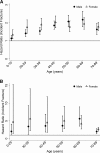Type 1 diabetes is associated with an increased risk of fracture across the life span: a population-based cohort study using The Health Improvement Network (THIN)
- PMID: 26216874
- PMCID: PMC4580610
- DOI: 10.2337/dc15-0783
Type 1 diabetes is associated with an increased risk of fracture across the life span: a population-based cohort study using The Health Improvement Network (THIN)
Abstract
Objective: This study was conducted to determine if type 1 diabetes is associated with an increased risk of fracture across the life span.
Research design and methods: This population-based cohort study used data from The Health Improvement Network (THIN) in the U.K. (data from 1994 to 2012), in which 30,394 participants aged 0-89 years with type 1 diabetes were compared with 303,872 randomly selected age-, sex-, and practice-matched participants without diabetes. Cox regression analysis was used to determine hazard ratios (HRs) for incident fracture in participants with type 1 diabetes.
Results: A total of 334,266 participants, median age 34 years, were monitored for 1.9 million person-years. HR were lowest in males and females age <20 years, with HR 1.14 (95% CI 1.01-1.29) and 1.35 (95% CI 1.12-1.63), respectively. Risk was highest in men 60-69 years (HR 2.18 [95% CI 1.79-2.65]), and in women 40-49 years (HR 2.03 [95% CI 1.73-2.39]). Lower extremity fractures comprised a higher proportion of incident fractures in participants with versus those without type 1 diabetes (31.1% vs. 25.1% in males, 39.3% vs. 32% in females; P < 0.001). Secondary analyses for incident hip fractures identified the highest HR of 5.64 (95% CI 3.55-8.97) in men 60-69 years and the highest HR of 5.63 (95% CI 2.25-14.11) in women 30-39 years.
Conclusions: Type 1 diabetes was associated with increased risk of incident fracture that began in childhood and extended across the life span. Participants with type 1 diabetes sustained a disproportionately greater number of lower extremity fractures. These findings have important public health implications, given the increasing prevalence of type 1 diabetes and the morbidity and mortality associated with hip fractures.
© 2015 by the American Diabetes Association. Readers may use this article as long as the work is properly cited, the use is educational and not for profit, and the work is not altered.
Figures


Comment in
-
Comment on Weber et al. Type 1 Diabetes Is Associated With an Increased Risk of Fracture Across the Life Span: A Population-Based Cohort Study Using The Health Improvement Network (THIN). Diabetes Care 2015;38:1913-1920.Diabetes Care. 2015 Dec;38(12):e204. doi: 10.2337/dc15-1751. Diabetes Care. 2015. PMID: 26604283 No abstract available.
-
Response to Comment on Weber et al. Type 1 Diabetes is Associated With an Increased Risk of Fracture Across the Life Span: A Population-Based Cohort Study Using The Health Improvement Network (THIN). Diabetes Care 2015;38:1913-1920.Diabetes Care. 2015 Dec;38(12):e205-6. doi: 10.2337/dci15-0019. Diabetes Care. 2015. PMID: 26604284 Free PMC article. No abstract available.
References
-
- Imkampe AK, Gulliford MC. Trends in Type 1 diabetes incidence in the UK in 0- to 14-year-olds and in 15- to 34-year-olds, 1991-2008. Diabet Med 2011;28:811–814 - PubMed
-
- DIAMOND Project Group . Incidence and trends of childhood Type 1 diabetes worldwide 1990-1999. Diabet Med 2006;23:857–866 - PubMed
-
- González EL, Johansson S, Wallander MA, Rodríguez LA. Trends in the prevalence and incidence of diabetes in the UK: 1996-2005. J Epidemiol Community Health 2009;63:332–336 - PubMed
-
- Hamann C, Kirschner S, Günther KP, Hofbauer LC. Bone, sweet bone--osteoporotic fractures in diabetes mellitus. Nat Rev Endocrinol 2012;8:297–305 - PubMed
Publication types
MeSH terms
Grants and funding
LinkOut - more resources
Full Text Sources
Other Literature Sources
Medical

